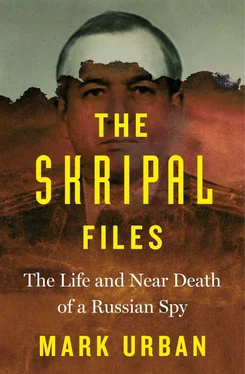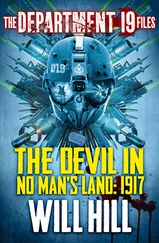While Sergei and Yulia weighed decisions about their future, the police investigation moved on. Early in June, Assistant Commissioner Dean Haydon reported, somewhat plaintively, ‘We continue to deal with a number of unique and complex issues in what is an extremely challenging investigation.’ But it was to be the fusion of data by the intelligence agencies and detectives that would turn the investigation around. By early July this had brought a handful of individuals into sharp focus; Scotland Yard had subjects of interest.
The type and quantity of Novichok used had been guided by a number of considerations: they had wanted it to enter Skripal’s body slowly, by absorption through the skin, in part to give the poisoner time to escape; the A234 was applied as a viscose liquid so it did not blow away when applied to the door handle; the quantity used was very small, not least because they did not want an operation that might kill many bystanders; such factors as the temperature and some of the liquid dripping off the door handle onto the ground could further have limited its effectiveness. In the matter of dosage, the experience of the hospital, Porton Down’s tests, and the police investigation all dovetailed nicely.
With regard to the perpetrator, the early assumption that they would have been part of a team of two or three grew as analysis of phone data caused them to narrow focus on a few people who had entered the country just before the poisoning and left the following day. A team was needed for the operation because one person might have been keeping watch while the Novichok was used, another possibly driving a vehicle to take them away. The contamination trail and the Skripals’ movements before they headed into town on 4 March had allowed the police to narrow down a couple of time windows for when the key perpetrator approached the front door. This led detectives to try to identify everybody who had been moving about in that part of Salisbury during those periods, a process that by early June had involved checking the identity of 14,000 vehicles and 2,500 pedestrians.
As for the people responsible, attention was focusing by July on a few who had left the country soon after the act. So the question was whether the police could tie anyone identified in Salisbury during those time windows to later transit through an airport or port. Initially investigators assumed that anyone with the backing of an organization like the FSB, SVR, or GRU would be very hard to spot.
Looking, by way of example, at the protocol used by Russian illegals in the West to return home for their occasional debriefs or during an emergency extraction, they are designed to thwart investigators. The hallmarks of these secret journeys were multiple identities, different countries, and switching forms of transport. But as investigators combined the datasets from Salisbury, the pointers suggested a more straightforward itinerary. And indeed there were precedents also for simply catching a flight straight back to Russia.
Andrei Lugovoi, the prime suspect in the Litvinenko case, took a plane directly back to Moscow, using his own name. There’s one other case worth remembering: Ruslan Atlangeriev, the man suspected of coming to London in June 2007 to murder Boris Berezovsky. Journalists’ attempts to track him down once he was deported back to Russia failed. He simply disappeared.
When journalists from the Press Association, a British news agency, revealed in mid-July that several suspects had been identified and that they were Russians, it prompted the security minister to condemn the story as ‘wild and ill-informed speculation’. As I heard it from my own contacts, they considered the PA report unhelpful because it was premature. Detectives had indeed by then identified suspects, and they had left the UK on Russian passports, but the identities they had used were believed to be false. Until they could find the true identity of those poisoning suspects, Scotland Yard didn’t want to say anything. After all, if they weren’t genuine identities, and the UK authorities hadn’t worked out the real ones, the possibility remained – however remote in the view of Whitehall – of a false-flag operation designed to tarnish Russia. They wanted to nail down the real identity of the hit team before any public naming of suspects.
This narrowing down of focus on subjects of interest coincided with a quite separate development – the identification of twelve GRU officers by the inquiry into Russian meddling in the 2016 US elections led by former FBI boss Robert Mueller. In this instance the US indictment revealed in remarkable detail the activities of a cyber-operations team that had presumably assumed it could operate from its offices in Moscow with complete anonymity. The US indictment named the GRU units, their physical locations, leading staff members, and their places within the organization. The relevance of this to the Salisbury investigation is threefold: it is another instance of a Western country calling out Russia (and specifically the GRU) for illegal activity; there was a presumption that the Kremlin would never agree to the delivery of these twelve officers for questioning in the US; and the Mueller investigation, by exploiting for forensic purposes cyber techniques normally kept highly secret, showed how the British might gather further information on the Salisbury operation, once it had discovered the true identity of its suspected perpetrators.
It comes as little surprise then that many of those I’ve spoken to since the poisoning assume that it may never be possible to try these people in a British court. Instead there could be charges levelled, arrest warrants issued, and further investigations conducted.
For the view of intelligence people is that the two or three member poisoning team were not the only elements of this operation.
Among them there is a belief that Skripal was likely under some physical surveillance before the attack in order to establish his pattern of life and check for CCTV coverage (or the lack of it) in the environs of his house. Although this means going back weeks or maybe even months, and therefore involves a potentially vast pool of people, the likely existence of a surveillance team suggests a larger operation.
Just as the search for a possible surveillance team added to the size and complexity of the investigation, so the shocking events in Wiltshire in June 2018 would both open new paths of inquiry and resolve some questions that detectives had struggled with since March. Four months after Sergei and Yulia found themselves fighting for their lives, another couple were in exactly the same predicament in Radnor Ward of Salisbury Hospital. Dawn Sturgess fell ill on the morning of 30 June in nearby Amesbury, and a few hours later her boyfriend, Charlie Rowley, also fell victim, with the telltale symptoms of sweating, pinpoint pupils, and a frothing mouth. The emergency services found drug-taking paraphernalia in the house.
By Tuesday, with the usual therapies for narcotic overdoses having little effect, the same intensive-care team that had saved the Skripals was sending samples from these new patients off to Porton Down. That evening they heard it was nerve-agent poisoning, and by the following day it was confirmed to be Novichok of the same type that had hit the earlier victims.
The police, taking action to cordon the places where they knew the couple had been during the twelve hours before falling ill, declared a major incident and the media interest took off. It didn’t take long for detectives from the Counter-Terrorist Network who were working the Skripal case to switch to the new incident. For this new poisoning seemed to offer some vital answers that had eluded them. Where had the March poisoner disposed of the Novichok container? How could they better focus their searches of CCTV and witness statements to find the suspects?
Читать дальше












